Comments / Questions (78)
![]() Domimique SCHULTZ wrote:
Domimique SCHULTZ wrote:
Merci pour ce cardigan simple chaud et efficace
27.03.2024 - 10:40
![]() Ellie wrote:
Ellie wrote:
Working the raglan increases - Right Side knit up to A.1. YO then A.1. = Knit, Purl without bringing YO, but it creates one YO because of the switch from K to P? Is this right? Each time I do the Wrong Side the increase feels really hard and it doesn’t look as good as the P YO K of the other side of the A.1.
16.03.2024 - 09:13DROPS Design answered:
Dear Ellie, A.1 is the raglan line and is worked as follows from the right side: purl 2, knit 1, purl 2. So you would work as follows: 1 yarn over, A.1, 1 yarn over. You can see here how to increase on each side of a raglan line (which would be A.1 in this pattern): https://www.garnstudio.com/video.php?id=592&lang=en. You shouldn't have extra yarn overs when switching from knitting to purling. Happy knitting!
17.03.2024 - 23:11
![]() Susan Braviak wrote:
Susan Braviak wrote:
In the beginning of the YOKE section, after completing row 1 and increasing by 8 stitches, is row 2 all purl except for the 5 band stitches on each end? Also, for Row 3 (right side) how are the 8 stitches from the first row incorporated into the pattern?
05.02.2024 - 18:04DROPS Design answered:
Hi Susan, Remember to work A.1 across each raglan-line (K2, P1, K2 on row 2 and each row from the wrong side, P2, K1, P2 on each row from the right side). All new stitches are worked into the stocking stitch (K from right side and P from wrong side) between each A.1. Happy knitting!
06.02.2024 - 06:57
![]() Lucille Pineault wrote:
Lucille Pineault wrote:
Comme le compte de mailles n’est pas tout à fait comme mentionné dans le patron, j’aimerais simplement savoir pour la manche raglan, si je dois mettre sur un fil en attente à partir de A1 et inclure les 5mailles de A1? Merci
22.01.2024 - 12:08DROPS Design answered:
Bonjour Mme Pineault, si vous n'avez pas le bon nombre de mailles, la division devra alors être réorganisée en fonction de votre tension/de la taille souhaitée, vous pouvez vous baser sur le schéma des mesures pour pouvoir adapter en fonction de ce que vous souhaitez. Bon tricot!
23.01.2024 - 07:06
![]() Lucille Pineault wrote:
Lucille Pineault wrote:
Comme je n’arrive pas tout à fait avec le nombre de mailles pour les manches, doit-on inclure pour la manche à partir des 2 mailles à l’envers et finir avec les 2 mailles à l’envers?
20.01.2024 - 20:03DROPS Design answered:
Bonjour Mme Pineault, je ne suis pas bien sûre de comprendre votre question, vous en êtes à la division à la fin de l'empiècement? Si vous avez bien le bon nombre de mailles au total, divisez bien les mailles comme indiqué pour avoir le bon nombre de mailles pour le bas du gilet et pour les manches. Les mailles des raglans sont comprises dans ce nombre de mailles, mais après la division, on les tricote en jersey . Bon tricot!
22.01.2024 - 08:46
![]() Caroline wrote:
Caroline wrote:
Bonjour, S’il vous plaît au moment de la séparation des manches, que doit-on faire des motifs raglans? Sont-ils à tricoter avec le déroulement du corps en mailles endroits? Je fais la taille 3 mois et n’arrive pas à trouver le même nombre de mailles de départ pour le corps. J’ai: (5+19+6+41+6+19+5)=101 + les 20 mailles de raglan 😊 Encore merci pour tous ces jolis modèles !
15.12.2023 - 11:18DROPS Design answered:
Bonjour Caroline, divisez l'empiècement comme indiqué, les mailles au début et à la fin des manches sont attribuées aux devants / au dos. Bon tricot!
15.12.2023 - 15:36
![]() Bord Hélène wrote:
Bord Hélène wrote:
Bonjour, Dans ce modèle Baby 42 .6 , après les augmentations il reste quelques rangs à tricoter afin d'obtenir la mesure voulue. Faut il exécuter ces rangs totalement en jersey ou doit on encore suivre le diagramme sans augmenter. Merci beaucoup de votre réponse. Cordialement.
15.09.2023 - 17:34DROPS Design answered:
Bonjour Mme Bord, tricotez les mailles comme avant, autrement dit en jersey avec A.1 jusqu'à la hauteur indiquée pour la taille concernée. Bon tricot!
18.09.2023 - 07:51
![]() Sandra wrote:
Sandra wrote:
What should the row be after increase the row of the first increase of 8 stitches.?
20.08.2023 - 04:02DROPS Design answered:
Dear Sandra, after the increases work the band stitches in garter stitch over the band stitches in the previous row, work row 2 of A.1 over the stitches in A.1 from the previous row (that is, work k2, p1, k2), purl over the knit stitches from the previous row and purl twisted the yarn overs from the previous row. Happy knitting!
20.08.2023 - 17:14
![]() Sandra wrote:
Sandra wrote:
Could you give what the row after increasing should be?
20.08.2023 - 03:59DROPS Design answered:
Dear Sandra, after the increases work the band stitches in garter stitch over the band stitches in the previous row, work row 2 of A.1 over the stitches in A.1 from the previous row (that is, work k2, p1, k2), purl over the knit stitches from the previous row and purl twisted the yarn overs from the previous row. Happy knitting!
20.08.2023 - 17:14
![]() Sandra wrote:
Sandra wrote:
After the row of increasing 8 stitches in total, is the next row, 5 band stitches and then purl to last 5 stitches for band, or do you opposite for A1 such as k2 p1 k2.
20.08.2023 - 03:55DROPS Design answered:
Dear Sandra, after the increases work the band stitches in garter stitch over the band stitches in the previous row, work row 2 of A.1 over the stitches in A.1 from the previous row (that is, work k2, p1, k2), purl over the knit stitches from the previous row and purl twisted the yarn overs from the previous row. Happy knitting!
20.08.2023 - 17:14
Dream in Blue Cardigan#dreaminbluecardigan |
|||||||
 |
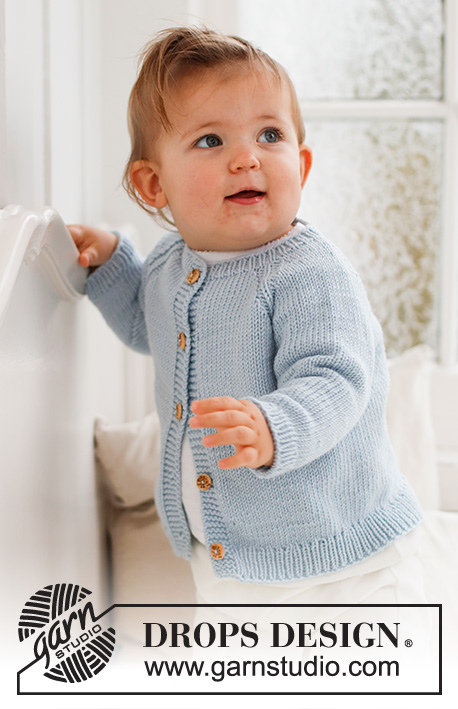 |
||||||
Knitted jacket for babies and children in DROPS Merino Extra Fine. The piece is worked top down with raglan. Sizes 0 - 4 years.
DROPS Baby 42-6 |
|||||||
|
------------------------------------------------------- EXPLANATIONS FOR THE PATTERN: ------------------------------------------------------- RIDGE/GARTER STITCH (worked back and forth): Knit all rows. 1 ridge = knit 2 rows. PATTERN: See diagram A.1. The diagram shows all rows in the pattern from the right side. DECREASE TIP (sleeves): Decrease 1 stitch on either side of the marker as follows: Work until there are 3 stitches left before the marker, knit 2 together, knit 2 (marker sits between these 2 stitches), slip 1 stitch as if to knit, knit 1 and pass the slipped stitch over the knitted stitch. BUTTONHOLES: Work buttonholes on the right band (when the garment is worn). Work from the right side when there are 3 stitches left on the row as follows: Make 1 yarn over, knit 2 together and knit 1. On the next row, knit the yarn over to leave a hole. The first buttonhole is worked when the rib on the neck measures 1½-2 cm = ½"-¾". Then work the other 4-4-4-4 (5-5) buttonholes with approx. 5-6-6½-7 (6½-7) cm = 2"-2⅜"-2½"-2¾" (2½"-2¾") between each one. ------------------------------------------------------- START THE PIECE HERE: ------------------------------------------------------- JACKET – SHORT OVERVIEW OF THE PIECE: The neck and yoke are worked back and forth with circular needle. The yoke is divided for the body and sleeves and the body continued back and forth. The sleeves are worked in the round with double pointed needles. NECK: Cast on 65-69-73-77 (81-87) stitches with circular needle size 3 MM = US 2.5 and DROPS Merino Extra Fine. Purl 1 row from the wrong side with 5 band stitches in GARTER STITCH – read description above, on each side. Then work rib as follows: 5 band stitches in garter stitch, * knit 1, purl 1 *, work from *-* until there are 6 stitches left, knit 1 and 5 band stitches in garter stitch. Remember the BUTTONHOLES – read description above. When the rib measures 2 cm = ¾", change to circular needle size 4 MM = US 6. Insert 1 marker after the band at the beginning of the row; the yoke is measured from this marker! YOKE: Work the next row from the right side as follows: 5 band stitches in garter stitch, knit 5-6-7-8 (8-10), 1 yarn over, A.1, 1 yarn over, knit 6-6-6-6 (8-8), 1 yarn over, A.1, 1 yarn over, knit 13-15-17-19 (19-21), 1 yarn over, A.1, 1 yarn over, knit 6-6-6-6 (8-8), 1 yarn over, A.1, 1 yarn over, knit 5-6-7-8 (8-10) and 5 band stitches in garter stitch. You have increased 8 stitches for raglan. The yarn overs are purled twisted on the next row and continued in stockinette stitch. Continue the pattern and increase on each side of A.1 on each row from the right side a total of 11-13-14-15 (17-18) times = 153-173-185-197 (217-231) stitches. REMEMBER THE KNITTING GAUGE! When the piece measures 9-10-11-12 (13-14) cm = 3½"-4"-4⅜"-4¾" (5⅛"-5½") from the marker, divide the yoke for the body and sleeves as follows: 5 band stitches in garter stitch, work 19-22-24-26 (29-32) stitches in stockinette stitch, place the next 32-36-38-40 (44-46) stitches on a thread for the sleeve, cast on 6-6-8-8 (6-6) stitches, work 41-47-51-55 (61-65) stitches in stockinette stitch, place the next 32-36-38-40 (44-46) stitches on a thread for the sleeve, cast on 6-6-8-8 (6-6) stitches, work 19-22-24-26 (29-32) stitches in stockinette stitch and 5 band stitches in garter stitch. BODY: = 101-113-125-133 (141-151) stitches. Continue back and forth with stockinette stitch and 5 band stitches in garter stitch on each side until the body measures 10-13-14-16 (18-21) cm = 4"-5⅛"-5½"-6¼" (7"-8¼") from the division. Now increase 10-12-14-14 (16-16) stitches evenly spaced on the next row from the right side (do not increase over the bands) = 111-125-139-147 (157-167) stitches. Change to circular needle size 3 MM = US 2.5 and work rib, starting from the wrong side as follows: 5 band stitches in garter stitch, * purl 1, knit 1 *, work from *-* until there are 6 stitches left, purl 1 and 5 band stitches in garter stitch. Bind off when the rib measures 3 cm = 1⅛". The jacket measures approx. 24-28-30-33 (36-40) cm = 9½"-11"-11¾"-13" (14¼"-15¾") from the shoulder down. SLEEVES: Place the 32-36-38-40 (44-46) stitches from the thread on the one side of the piece on double pointed needles size 4 MM = US 6 and knit up 1 stitch in each of the 6-6-8-8 (6-6) stitches cast on under the sleeve = 38-42-46-48 (50-52) stitches. Insert a marker in the middle of the new stitches under the sleeve (= mid-under sleeve). Start at the marker and work stockinette stitch in the round. When the sleeve measures 2 cm = ¾" from the division, decrease 1 stitch on each side of the marker - read DECREASE TIP! Decrease like this every 3-3-2-2½ (3-4) cm = 1⅛"-1⅛"-¾"-1" (1⅛"-1½") a total of 2-3-5-5 (5-5) times = 34-36-36-38 (40-42) stitches. When the sleeve measures 8-11-12-15 (18-23) cm = 3⅛"-4⅜"-4¾"-6" (7"-9"), increase 4-4-4-4 (4-6) stitches evenly spaced = 38-40-40-42 (44-48) stitches. Change to double pointed needles size 3 MM = US 2.5 and work rib (knit 1, purl 1) for 2 cm = ¾". Bind off. The sleeve measures approx. 10-13-14-17 (20-25) cm = 4"-5⅛"-5½"-6¾" (8"-9¾"). Work the other sleeve in the same way. |
|||||||
Diagram explanations |
|||||||
|
|||||||
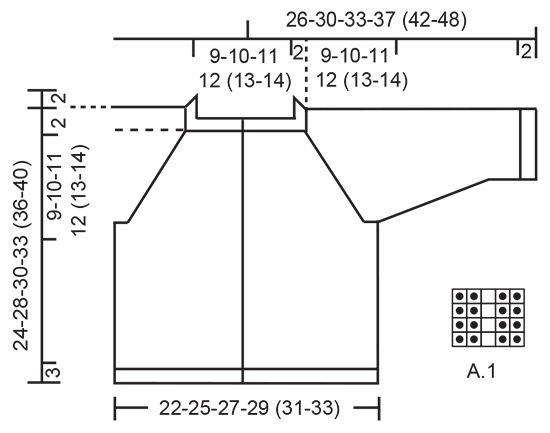 |
|||||||
Have you finished this pattern?Tag your pictures with #dropspattern #dreaminbluecardigan or submit them to the #dropsfan gallery. Do you need help with this pattern?You'll find 27 tutorial videos, a Comments/Questions area and more by visiting the pattern on garnstudio.com. © 1982-2025 DROPS Design A/S. We reserve all rights. This document, including all its sub-sections, has copyrights. Read more about what you can do with our patterns at the bottom of each pattern on our site. |
|||||||







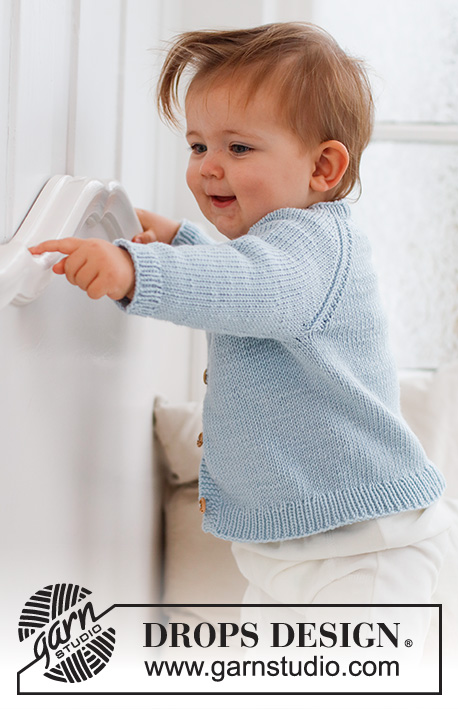
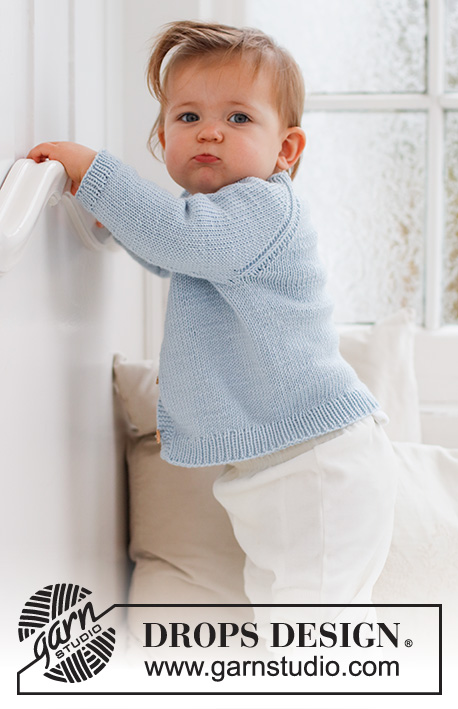
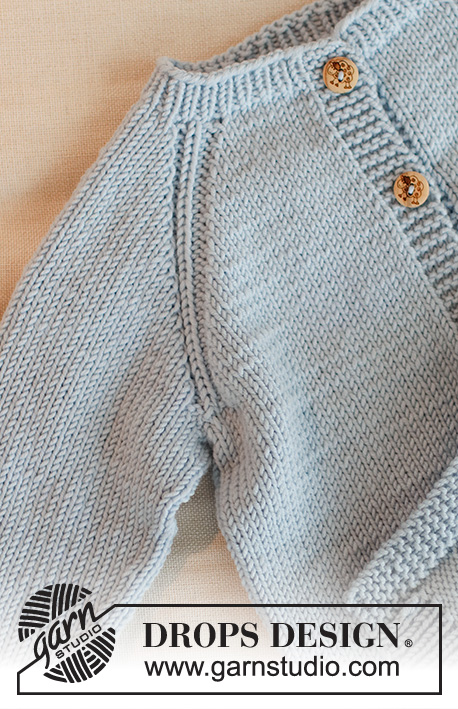

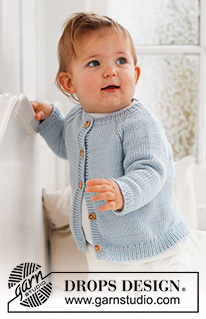
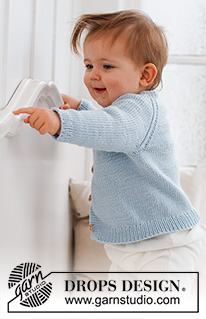
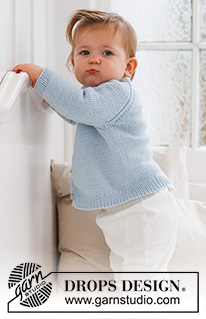
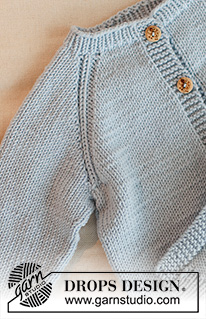






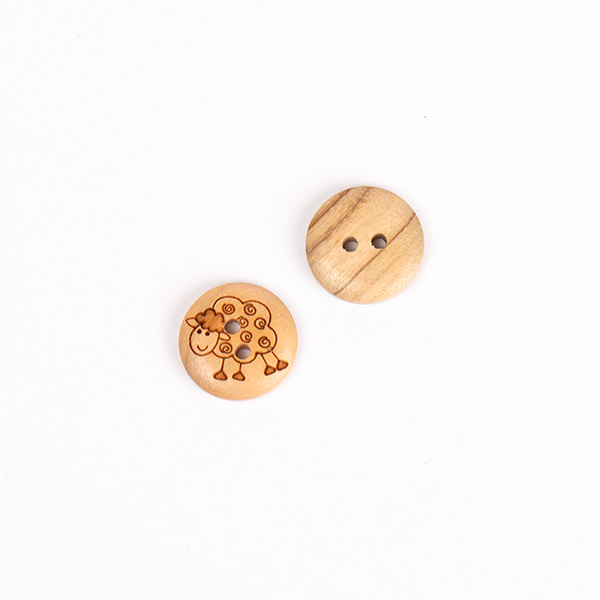

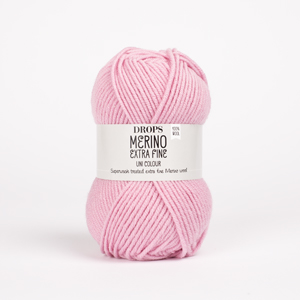
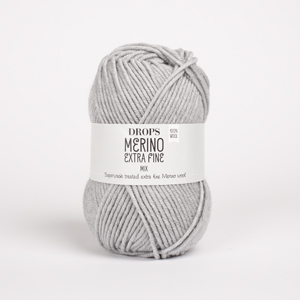


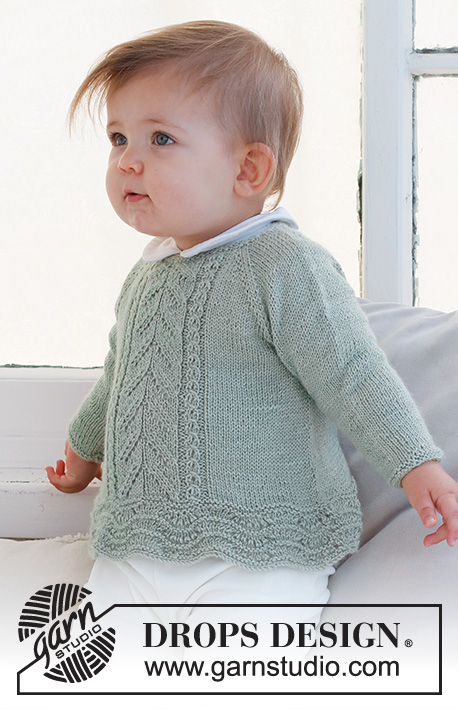













































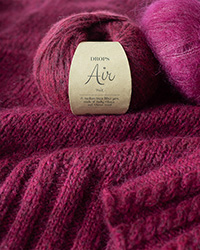
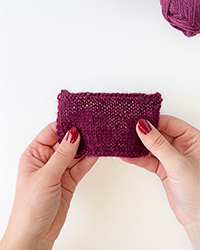

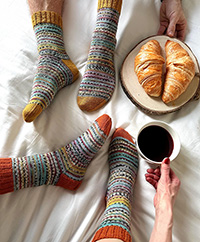
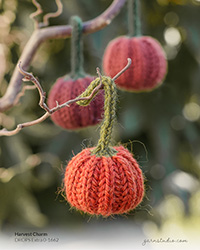

Post a comment to pattern DROPS Baby 42-6
We would love to hear what you have to say about this pattern!
If you want to leave a question, please make sure you select the correct category in the form below, to speed up the answering process. Required fields are marked *.